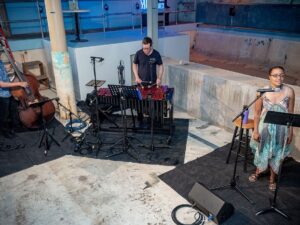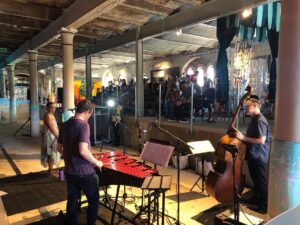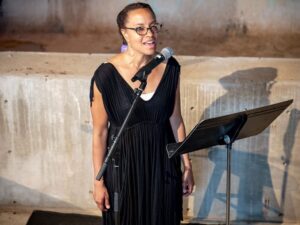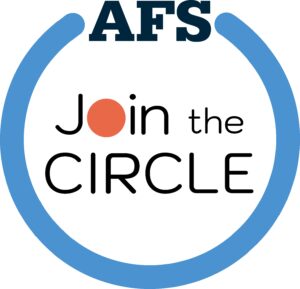In July 2022, Lower School Music Teacher Keisha Hirlinger and her husband Doug Hirlinger were commissioned to write and perform Water Speaks, a 8-piece suite, by the Philadelphia Jazz Project and performed as a part of an exhibit at Fairmount Water Works in Philadelphia. They will be performing Water Speaks, as part of a series of musical performances convened by Intercultural Journeys called Table Sessions, coming up in March. Water Speaks explores the legacy of segregation through the lack of access to water, specifically pools and beaches, throughout history and in the present. Keisha discusses the development of their suite, Water Speaks, the creative process, collaboration, her work with Intercultural Journeys, and the joys of creation.
Can you start by describing your movement, Water Speaks?
Water Speaks is really a conversation. It’s eight pieces featuring voice, vibraphone and bass, that tells the story of the relationship of Black Americans and their ancestors to the water, tracing the route from West Africa through the Middle Passage to the shores of the United States. The way that we set it up, it begins with the origin story—the idea that there was a thriving, joyful community that had nothing to do with what happened once they had to survive in another world. It was really important to us to really center Black people from a source of strength, not just oppression in the Americas. But critically, the story is from the perspective of the water. It’s the water explaining that Black people have always had a connection to the water.
Where did you get the inspiration and ideas for the suite?
I think it was really powerful for me, as a Black woman who has had a lot of privilege around pools to engage with this story. I had swimming lessons when I was a baby. I was on a swim team for many years. For my brother and I, being able to swim was always a point of strength and pride, so I never felt scared.
 But that’s not always the case. There’s a piece called Mother’s Mourning, which is really dedicated to loss, and just the losses happening because of lack of access for swimming for Black communities. According to the Centers for Disease Control and Prevention, Black children and teenagers are almost six times as likely as white children to drown in a swimming pool. In the exhibit at Pool, there was a story that really affected me as a mother about a family in 2010, which was not that long ago, having a picnic at a water bank, with these six children. One child went into the water and couldn’t swim. None of them could swim. Each of them kept going in to save the other one. It was horrific. I felt like that story of loss needed to be lifted up and held. In the piece, you hear the water lamenting this loss as a result of it doing what is in its nature.
But that’s not always the case. There’s a piece called Mother’s Mourning, which is really dedicated to loss, and just the losses happening because of lack of access for swimming for Black communities. According to the Centers for Disease Control and Prevention, Black children and teenagers are almost six times as likely as white children to drown in a swimming pool. In the exhibit at Pool, there was a story that really affected me as a mother about a family in 2010, which was not that long ago, having a picnic at a water bank, with these six children. One child went into the water and couldn’t swim. None of them could swim. Each of them kept going in to save the other one. It was horrific. I felt like that story of loss needed to be lifted up and held. In the piece, you hear the water lamenting this loss as a result of it doing what is in its nature.
But we made sure to end the suite with joy and hope. The water can be safe. There’s a closing acapella piece called “Come Into the Water” for a child—it’s about reclaiming the water, that we can be a part of the water and the water is ours and we have access to it. Our final piece, “Joy is Life” reminds us that we as Black people are more than the oppressive stories and that there is strength and joy.
Do you think that that’s the kind of thing that could be captured in a recording? Or is the acoustic component, having it in that space, an important integral part of it do you think?
I always consider space as a singer. You want to see how it feels coming back to you. If it’s really live, it’s a lot of feedback for you. If it’s a kind of dead space, it can be harder to fill in a way. You’re looking for that feedback, that warmth, when you’re singing. That’s why singing in churches, with those high vaulted ceilings and long halls—it just feels good. You don’t need to stretch your voice, it all comes back to you. My husband Doug is the vibraphone player, and the way he plays in space—like when we performed in the empty cement pool in the Philadelphia Water Works for our first performance—is going to sound different in the space we are performing in March. The same will be true for the bass. The way that a space holds sound is always different depending on the environment. The pools were a more live environment sonically, so we had to be aware of how we were controlling the sound in the space. Rittenhouse Soundworks was created specifically for performance. So it will be a more controlled environment in terms of the way the sound is heard and felt.
 What was it like collaborating on this project with your husband? Is it hard to commit to a shared vision, or do your ideas align relatively neatly?
What was it like collaborating on this project with your husband? Is it hard to commit to a shared vision, or do your ideas align relatively neatly?
We’re really complementary, actually, even though we create and perform different kinds of music. My husband plays improvised and experimental music. I’m a singer songwriter and a classically trained singer. My music is informed by American folk traditions and Black musical traditions from spirituals to 70s RnB. In our 20s, we worked together on albums and a few projects, but we haven’t actually worked together on a project in over 10 years. So, it was special because we’re all grown up, we’re married, and approach our collaboration with more insight and maturity. But I feel like the first day we worked together, we were dusting off our collaboration style. We both knew we definitely wanted the suite to start from a place of strength, and this idea of being from the perspective of the water was really cool, so we talked about that and how we could capture that voice and perspective. We also understood the importance of working independently, and the importance of having our own creative processes. What resulted was music that was meaningful to both of us. This project felt special to me because the music poured out of me. It felt like this was something that I needed to write. I’m so grateful that I had the opportunity to perform the work at SPLASH, and I’m excited to perform it again for Table Sessions at Intercultural Journeys.
After you developed this movement, you performed it for SPLASH and then again at Arcadia University. Now, you’ll be performing it three times with Intercultural Journeys as part of their Table Sessions series at the Rittenhouse Soundworks. Are you expecting this performance to be different?
Absolutely, each performance has been unique. This upcoming performance is bringing together so many amazing people in my life. We chose Rittenhouse Soundworks in Germantown because it’s an amazing, beautiful space and we live in Northwest Philly. I went to school in Germantown all of my life. So this location was intentional and where we have community.
Something unique about the Table Sessions is that the performances are paired with food. We knew immediately who we wanted to curate our food, Chef Jay Battersbee, a close friend and [Lower School science teacher] Rasheeda Murphy’s husband. He’s making jerk chicken and jerk eggplant as a vegan option, rice and peas, fried cabbage. This menu was intentionally curated by Chef Jay to compliment the cultural significance connected to Water Speaks.
We asked another close friend, M’Balia Singley, who’s an incredible artist in her own right, to moderate the discussion portion of the evening. We chose MB because she is a gifted and insightful artist who is knowledgeable about Black narratives and histories.
Another one of my closest friends growing up, Melissa Koomson, is a beautiful artist and crafter. Her clothing is created from traditional Ghanaian cloth, where her husband is from and where she has also lived. I asked her to make me a jacket made from traditional Ghanaian cloth. She took me to the Ghanaian Market via FaceTime with all these beautiful fabrics. I told her the colors I wanted, some sort of blue, like the water, and yellow, because I love sunflowers. She showed me this pattern and explained it was called nsubura. It is a circular pattenn with tiny dots in aspiral formation that are supposed to resemble the ripples made in a well when fetching water, or when a stone is dropped into its depths. The design serves as a reminder of the impact our actions have on others-a ripple effect. It was perfect!
So there’s many personal connections that make this event extra special.

What is it that drew you to Intercultural Journeys as an organization?
It’s a small but mighty organization that really wants to lift up all different kinds of artists from all different walks of life to all different kinds of people. For example, IJ cares deeply about accessibility and cost, so they’ve instituted a sliding cost scale for tickets. It’s $15 to $45, whatever you feel you can pay. This creates a more inclusive and accessible experience for everyone.
I’m really proud to be serving as president of the board. I think a lot of people are priced out of these kinds of events or feel like this isn’t for them. Theater and performance can feel very elitist—we’re over here, you’re over there. It’s really important for the organization to create a space where no matter your socioeconomic status, or your race, your sexual orientation, or your gender identity—we want to see you in the audience. This art is for everyone.


